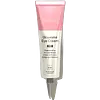What's inside
What's inside
 Key Ingredients
Key Ingredients

 Benefits
Benefits

 Concerns
Concerns

 Ingredients Side-by-side
Ingredients Side-by-side

Centella Asiatica Extract
CleansingGlycerin
HumectantButylene Glycol
HumectantDipentaerythrityl Hexa C5-9 Acid Esters
Skin Conditioning1,2-Hexanediol
Skin ConditioningNiacinamide
SmoothingSqualane
EmollientWater
Skin ConditioningPolyglyceryl-3 Distearate
EmulsifyingCetearyl Alcohol
EmollientCaprylic/Capric Triglyceride
MaskingBetaine
HumectantButyrospermum Parkii Butter
Skin ConditioningHeptyl Undecylenate
EmollientLactobacillus/Centella Asiatica Extract Ferment Filtrate
Skin ConditioningGlyceryl Stearate
EmollientBakuchiol
AntimicrobialPanthenol
Skin ConditioningAcrylates/C10-30 Alkyl Acrylate Crosspolymer
Emulsion StabilisingPalmitic Acid
EmollientTromethamine
BufferingStearic Acid
CleansingGlyceryl Stearate Citrate
EmollientCarbomer
Emulsion StabilisingEthylhexylglycerin
Skin ConditioningAdenosine
Skin ConditioningMacadamia Ternifolia Seed Oil
EmollientSodium Phytate
Sodium Hyaluronate
HumectantHydrogenated Lecithin
EmulsifyingCeramide NP
Skin ConditioningGlyceryl Acrylate/Acrylic Acid Copolymer
HumectantDextrin
AbsorbentTheobroma Cacao Extract
Skin ConditioningPolyglyceryl-10 Myristate
Skin ConditioningPhytosphingosine
Skin ConditioningMadecassic Acid
Skin ConditioningAsiaticoside
AntioxidantHydrolyzed Extensin
Skin ConditioningSucrose Distearate
EmollientAsiatic Acid
Skin ConditioningLauric Acid
CleansingPhytosterols
Skin ConditioningHydrolyzed Hyaluronic Acid
HumectantCaprylyl Glycol
EmollientAcetyl Hexapeptide-8
HumectantCentella Asiatica Extract, Glycerin, Butylene Glycol, Dipentaerythrityl Hexa C5-9 Acid Esters, 1,2-Hexanediol, Niacinamide, Squalane, Water, Polyglyceryl-3 Distearate, Cetearyl Alcohol, Caprylic/Capric Triglyceride, Betaine, Butyrospermum Parkii Butter, Heptyl Undecylenate, Lactobacillus/Centella Asiatica Extract Ferment Filtrate, Glyceryl Stearate, Bakuchiol, Panthenol, Acrylates/C10-30 Alkyl Acrylate Crosspolymer, Palmitic Acid, Tromethamine, Stearic Acid, Glyceryl Stearate Citrate, Carbomer, Ethylhexylglycerin, Adenosine, Macadamia Ternifolia Seed Oil, Sodium Phytate, Sodium Hyaluronate, Hydrogenated Lecithin, Ceramide NP, Glyceryl Acrylate/Acrylic Acid Copolymer, Dextrin, Theobroma Cacao Extract, Polyglyceryl-10 Myristate, Phytosphingosine, Madecassic Acid, Asiaticoside, Hydrolyzed Extensin, Sucrose Distearate, Asiatic Acid, Lauric Acid, Phytosterols, Hydrolyzed Hyaluronic Acid, Caprylyl Glycol, Acetyl Hexapeptide-8
Water
Skin ConditioningUrea
BufferingGlycerin
HumectantBacillus Ferment
Skin ConditioningCetyl Alcohol
EmollientGlyceryl Stearate
EmollientCoco-Caprylate
EmollientTocopherol
AntioxidantSodium Ascorbyl Phosphate
AntioxidantHexylresorcinol
AntimicrobialSodium Anisate
AntimicrobialSodium Levulinate
Skin ConditioningLactic Acid
BufferingSclerotium Gum
Emulsion StabilisingXanthan Gum
EmulsifyingCetyl Hydroxyethylcellulose
Emulsion StabilisingGlyceryl Caprylate
EmollientFerulic Acid
AntimicrobialSimmondsia Chinensis Seed Oil
EmollientOryza Sativa Bran Oil
EmollientDalea Spinosa Seed Oil
MaskingSodium Phytate
Caprylyl Glycol
EmollientHibiscus Sabdariffa Flower Extract
Skin ConditioningSambucus Nigra Flower Extract
RefreshingGinkgo Biloba Leaf Extract
Skin ConditioningPalmitoyl Proline
Skin ConditioningTripeptide-5
Skin ConditioningAcetyl Hexapeptide-8
HumectantWater, Urea, Glycerin, Bacillus Ferment, Cetyl Alcohol, Glyceryl Stearate, Coco-Caprylate, Tocopherol, Sodium Ascorbyl Phosphate, Hexylresorcinol, Sodium Anisate, Sodium Levulinate, Lactic Acid, Sclerotium Gum, Xanthan Gum, Cetyl Hydroxyethylcellulose, Glyceryl Caprylate, Ferulic Acid, Simmondsia Chinensis Seed Oil, Oryza Sativa Bran Oil, Dalea Spinosa Seed Oil, Sodium Phytate, Caprylyl Glycol, Hibiscus Sabdariffa Flower Extract, Sambucus Nigra Flower Extract, Ginkgo Biloba Leaf Extract, Palmitoyl Proline, Tripeptide-5, Acetyl Hexapeptide-8
 Reviews
Reviews

Ingredients Explained
These ingredients are found in both products.
Ingredients higher up in an ingredient list are typically present in a larger amount.
Acetyl Hexapeptide-8, commonly known as Argireline or Acetyl Hexapeptide-3, is a popular peptide in skincare. It’s often referred to as a “Botox-like” ingredient because it helps reduce muscle movement.
By relaxing these micro-movements, Argireline may help minimize the appearance of fine lines and wrinkles. That said, it’s not as powerful as Botox, and research on its long-term effectiveness is still limited.
Beyond smoothing, Argireline may also support collagen production. Collagen is the protein that helps keep your skin firm, bouncy, and well-hydrated by strengthening the skin barrier.
So while Argireline isn’t a miracle fix, it can be a helpful addition to a routine focused on both prevention and skin health.
Read more about other common types of peptides here:
Learn more about Acetyl Hexapeptide-8Caprylyl Glycol is a humectant and emollient, meaning it attracts and preserves moisture.
It is a common ingredient in many products, especially those designed to hydrate skin. The primary benefits are retaining moisture, skin softening, and promoting a healthy skin barrier.
Though Caprylyl Glycol is an alcohol derived from fatty acids, it is not the kind that can dry out skin.
This ingredient is also used as a preservative to extend the life of products. It has slight antimicrobial properties.
Learn more about Caprylyl GlycolGlycerin is already naturally found in your skin. It helps moisturize and protect your skin.
A study from 2016 found glycerin to be more effective as a humectant than AHAs and hyaluronic acid.
As a humectant, it helps the skin stay hydrated by pulling moisture to your skin. The low molecular weight of glycerin allows it to pull moisture into the deeper layers of your skin.
Hydrated skin improves your skin barrier; Your skin barrier helps protect against irritants and bacteria.
Glycerin has also been found to have antimicrobial and antiviral properties. Due to these properties, glycerin is often used in wound and burn treatments.
In cosmetics, glycerin is usually derived from plants such as soybean or palm. However, it can also be sourced from animals, such as tallow or animal fat.
This ingredient is organic, colorless, odorless, and non-toxic.
Glycerin is the name for this ingredient in American English. British English uses Glycerol/Glycerine.
Learn more about GlycerinGlyceryl Stearate is a mix of glycerin and stearic acid.
It is used to stabilize the mixing of water and oil ingredients. By preventing these ingredients from separating, it can help elongate shelf life. It can also help thicken the product's texture.
As an emollient, it helps soften skin and supports barrier-replenishing ingredients.
In cosmetics, Glyceryl Stearate is often made from vegetable oils or synthetically produced.
This ingredient may not be fungal-acne safe
Fun fact: The human body also creates Glyceryl Stearate naturally.
Learn more about Glyceryl StearateSodium Phytate is the synthetic salt form of phytic acid. Phytic acid is an antioxidant and can be found in plant seeds.
Sodium Phytate is a chelating agent. Chelating agents help prevent metals from binding to water. This helps stabilize the ingredients and the product.
Water. It's the most common cosmetic ingredient of all. You'll usually see it at the top of ingredient lists, meaning that it makes up the largest part of the product.
So why is it so popular? Water most often acts as a solvent - this means that it helps dissolve other ingredients into the formulation.
You'll also recognize water as that liquid we all need to stay alive. If you see this, drink a glass of water. Stay hydrated!
Learn more about Water